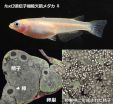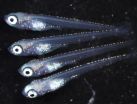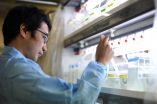To be sperm, or not to be sperm?
Discovery of the genetic switch that determines germ cell fate
2015-06-11
(Press-News.org) This news release is available in Japanese.
Researchers in Japan have found, for the first time in vertebrates, a genetic switch that determines whether germ cells become sperm or eggs. The gene is named foxl3, and has been identified using a small fish called medaka (Oryzias latipes). In medaka without this gene's functionality, surprisingly, sperm are produced in the ovaries of females. The sperm that are produced function normally, and have been confirmed to produce normal offspring. These results will be announced in the journal Science through Science Express the online pre-print version on June 11th.
Dr. Toshiya Nishimura, Associate Professor Minoru Tanaka and their colleagues of the National Institute for Basic Biology, National Institutes of Natural Sciences, in collaboration with Dr. Satoru Kobayashi of the Okazaki Institute for Integrative Bioscience, and through joint research with Kyushu University's Dr. Mikita Suyama and Dr. Yasuyuki Ohkawa, revealed that the foxl3 gene works in the germ cells of females "to suppress differentiation into sperm".
In females lacking functional foxl3 genes, the small fish's body appearance is still totally female, however a large number of sperm are formed in the ovaries, and a small number of eggs are formed at the same time.
It has also become clear that in these females lacking the function of foxl3 functional sperm can be obtained in a shorter period of time than in normal wild-type males. Applied research into uses for aquaculture is already underway.
"In spite of the environment surrounding the germ cells being female, the fact that functional sperm has been made surprised me greatly. That this sexual switch present in the Germ Cells is independent of the body's sex is an entirely new finding," Dr. Nishimura said.
Dr. Tanaka commented: "While germ cells can become either sperm or eggs, nobody knew that in vertebrates the germ cells have a switch mechanism to decide their own sperm or egg fate. Our result indicates that once the decision is made the germ cells have the ability to go all the way to the end. I believe it is of very large significance that this mechanism has been found."
INFORMATION:
Journal Information:
Science (Published through Science Express on June 11, 2015)
Title: foxl3 is a germ cell-intrinsic factor involved in sperm-egg fate decision in medaka
Authors: Toshiya Nishimura, Tetsuya Sato, Yasuhiro Yamamoto, Ikuko Watakabe, Yasuyuki Ohkawa, Mikita Suyama, Satoru Kobayashi, and Minoru Tanaka.
ELSE PRESS RELEASES FROM THIS DATE:
2015-06-11
EDMONTON, Canada, June 11 -- In this summer's much anticipated blockbuster Jurassic World, actor Chris Pratt joins forces with a pack of swift and lethal velociraptors. 'Velociraptor belongs to a group of predatory dinosaurs called the deinonychosaurs, or simply the 'raptors',' says University of Alberta paleontologist Scott Persons. 'Raptors are characterized by particularly nasty feet. Their big toes each bore an enlarged and wickedly hooked talon, which makes raptors well suited for Hollywood fight scenes.'
Persons and University of Alberta alumnus Lida Xing are part ...
2015-06-11
A NASA mission led by UCLA professor Christopher Russell has released new images of the dwarf planet Ceres, the largest asteroid between Mars and Jupiter.
The photos were produced by the spacecraft Dawn, which is now observing Ceres from 2,700 miles above its surface; NASA has also produced a one-minute video animation that sheds new light on this mysterious and heavily cratered world.
'Everything we learn from Ceres will be absolutely new,' said Christopher Russell, a UCLA professor of space physics and planetary science, and the Dawn mission's principal investigator. ...
2015-06-11
Philadelphia, June 11 -- The Maillard reaction is a chemical reaction between amino acids and reducing sugars that results in browned foods like seared steaks and toasted bread. When proteins and sugars are mixed together and heated, new chemical compounds are formed. Some are responsible for new flavors and some, according to a new study published in the Journal of Dairy Science®, may protect us against cardiovascular disease.
Researchers at the R&D Center, Seoul Dairy Cooperative, the College of Life Science & Biotechnology, Korea University, and the BK21 Plus Graduate ...
2015-06-11
People with autism are often described as "seeing the world differently." They tend to show superior perception for details, like, for example, the autistic artist Stephen Wiltshire's highly accurate representations of cityscapes drawn from memory. Now, researchers reporting in the Cell Press journal Current Biology on June 11 show that those differences in perceptual skill are present very early in infancy, before the onset of clinical symptoms of autism.
The researchers say that the findings may shift scientists' view of autism by suggesting that changes in perception ...
2015-06-11
Sometimes it takes a long time to solve a puzzle: In 1893, German surgeon G. Reinbach discovered that tumor tissue is often infiltrated by special cells of the immune system called eosinophils. Ever since then, scientists have been trying to figure out if and how these cells, which are part of the innate immune system, are involved in cancer rejection.
"There are many studies that link the presence of eosinophils in a tumor with an improved prognosis of the disease. However, even 120 years after Reinbach's discovery, it still remained elusive whether or not eosinophils ...
2015-06-11
ANN ARBOR--We've all been there: We eat an entire sleeve of fat-free, low-calorie cookies and we're stuffing ourselves with more food 15 minutes later.
One theory to explain this phenomenon is that artificial sweeteners don't contain the calories or energy that evolution has trained the brain to expect from sweet-tasting foods, so they don't fool the brain into satisfying hunger. However, until now, nobody understood how organisms distinguish between real sugar and artificial sweetener.
Now, a researcher at the University of Michigan has discovered how the brain of ...
2015-06-11
Millimeter-wave (mmWave) wireless technology promises to support high-bandwidth content at speeds exceeding 10 gigabits per second--a thousand times today's current mobile phone download speeds--but with that promise comes public concern about the health risks associated with utilizing the high-frequency radio waves in that spectrum.
A multidisciplinary team of NYU researchers notes that unlike X-rays and gamma rays, which are called "ionizing radiation" and are known to cause genetic mutations due to their excessive energy levels, millimeter waves are "non-ionizing," ...
2015-06-11
With age, postmenopausal women with osteoporosis are at greater risk of losing their teeth. But what treatment for tooth loss provides women with the highest degree of satisfaction in their work and social lives?
A new study by Case Western Reserve University School of Dental Medicine researchers suggests dental implants may be the best route to take, according to Leena Palomo, associate professor of periodontics and corresponding author of "Dental Implant Supported Restorations Improve the Quality of Life in Osteoporotic Women."
Their findings were reported in the ...
2015-06-11
URBANA, Ill. - Threonine is an indispensable amino acid, which is often provided in supplement form in swine diets. With U.S. production of crystalline amino acids increasing, more co-products from amino acid production are becoming available, and these co-products can also be fed to pigs. Researchers at the University of Illinois are investigating a co-product of synthetic threonine as a lower-cost alternative protein source to fish meal.
"To create synthetic threonine, you ferment a carbohydrate substrate using selected strains of bacteria, then extract the crystalline ...
2015-06-11
Having had community-acquired pneumonia (CAP) greatly increases the risk of long-term morbidity and mortality compared to the general population who have never had CAP, according to a new study from researchers in Canada, the longest and largest outcomes study of patients with CAP reported to date.
"Although the short-term adverse health consequences of CAP are well known, the long-term effects of the disease are less clear," said Dean T. Eurich, PhD, MSc, BSP, of the University of Alberta in Edmonton, Alberta, Canada. "In our large population-based study of more than ...
LAST 30 PRESS RELEASES:
[Press-News.org] To be sperm, or not to be sperm?
Discovery of the genetic switch that determines germ cell fate



